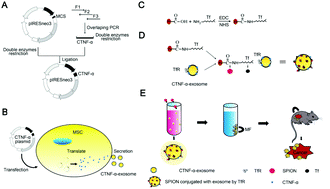SPION decorated exosome delivery of TNF-α to cancer cell membranes through magnetism†
Abstract
Tumor necrosis factor (TNF-α) is capable of inducing apoptosis and is a promising candidate for genetic engineering drugs in cancer therapy; however, the serious side-effects of TNF-α hinder their clinical application. In the present study, a method for preparing fusion proteins of cell-penetrating peptides (CPP) and TNF-α (CTNF-α)-anchored exosomes coupled with superparamagnetic iron oxide nanoparticles (CTNF-α-exosome-SPIONs) with membrane targeting anticancer activity has been demonstrated. To acquire exosomes with TNF-α anchored in its membrane, a CTNF-α expression vector was constructed and a stable mesenchymal stem cell cell line that expressed CTNF-α was established. Conjugating transferrin-modified SPIONs (Tf-SPIONs) onto CTNF-α-exosomes through transferrin–transferrin receptor (Tf-TfR) interaction yields CTNF-α-exosome-SPIONs with good water dispersibility. The incorporation of TNF-α into exosomes and the conjugation of SPIONs significantly enhanced the binding capacity of TNF-α to its membrane-bound receptor TNFR I, thus increasing the therapeutic effects. CTNF-α-exosome-SPIONs significantly enhanced tumor cell growth inhibition via induction of the TNFR I-mediated apoptotic pathway. In vivo studies using murine melanoma subcutaneous cancer models showed that TNF-α-loaded exosome-based vehicle delivery enhanced cancer targeting under an external magnetic field and suppressed tumor growth with mitigating toxicity. Taken together, our results suggest that CTNF-α-exosome-SPIONs showed great potential in membrane targeting therapy.



 Please wait while we load your content...
Please wait while we load your content...